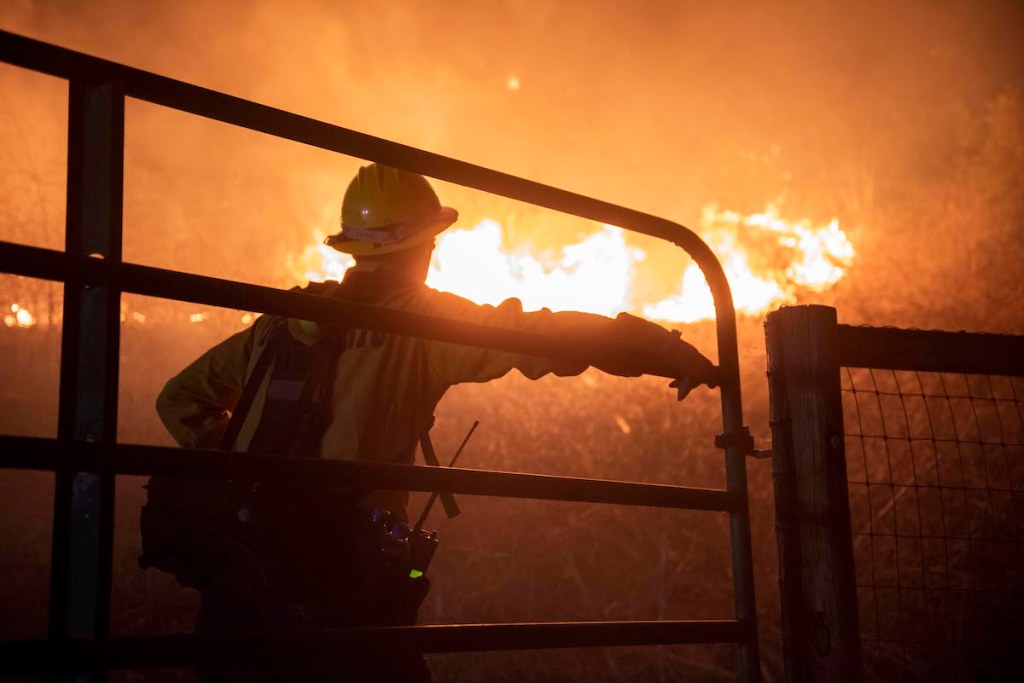The first whiff of the coming inferno was the snap hooks’ insistent clinking against the metal flagpole just outside our old ranch house. High air pressure — many miles north of our narrow perch along the southern skirt of the Santa Ynez range — propelled the hot offshore winds down our canyon en route to Refugio Beach, rousing our large California Republic flag from its customary droop and tensing its halyard.
By late that Monday afternoon, we could see enormous flames under a dark cumulus plume of brown smoke, surmounting the crest of the Santa Ynez south of Solvang. The fire was bearing southeast into the upper Tajiguas drainage, torching a tinderbox of chaparral on the coast side, which hadn’t burned since 1955. Embers hopscotched toward the beach, igniting dry brush erratically on their way. By 6 p.m., the highway was closed. The coast is ominously quiet when the 101 shuts down and we can again hear the persistent waves breaking on the beach from miles up-canyon, a small blessing from the emergency closure.
We knew from our experience in the 2016 Sherpa Fire that we had work to do and wouldn’t sleep for some time. Our cousin Eric came to lay out our fire hoses and connect them to the hydrants. To ensure access for the anticipated firefighters, deputies, and other officials, we propped open routinely locked gates. We located our Coleman lanterns, turned off the propane tanks, and filled the tractors, trucks, and generators with fuel.
When power poles burn, we can no longer pump irrigation or drinking water; we’re not adapted to off-grid farming. We topped off the hilltop reservoir and bottled a week’s supply of drinking water. As a teenager, I once complained to my grandmother that the large power pole outside our kitchen window, installed during FDR’s rural electrification effort in the late 1930s, was an eyesore. She looked at me and said evenly, “You never lived here without electricity. I love looking at that pole.”
Sign up for Indy Today to receive fresh news from Independent.com, in your inbox, every morning.
After numerous fire and debris flow evacuations, we know what to put in the car — passport, prescriptions, wallet, checkbook, glasses, a few paintings, an 1880s portrait of our grandfather’s grandfather, and a cigar box full of letters and postcards from our mother and grandmother. Last, a flashlight, cell phone and battery, and, of course, the dog. That’s about it.
I spent the first night in the duly loaded car on top of a peak with a view from Hope Ranch to Gaviota Peak. By morning, the wind shifted in our direction. Our cousins Adam and Taylor ATV’d up to the peak from their ranch in Refugio Canyon. Our respective great-grandparents had settled in adjoining canyons in the 1800s, and we typically visit during emergencies. Together, we watched the fire burn east from Tajiguas through Aguajitos Canyon and start down the ridge toward the cousins’ ranch on Refugio Creek, the bright flames bursting intermittently in the rugged landscape.
The fire burned through our ranch on Tuesday, a day of urgency, cacophony, smoke, and color. The sun was as red as the lights on the fire trucks. The hand crews’ yellow helmets and huge yellow bulldozers stood out against the brown smoke. The spray from the helicopters dipping in the reservoir was as white as the ash raining down from the sky. Five deer ran randomly through avocado orchards next to our barns, obviously frightened and confused. The background music was the battle-like chuff-chuff of helicopters’ rotors as they flew low over us to their next drop.
By Tuesday evening, the fire had moved on, closing in on our cousins Mark’s and then Kathy’s ranches, both bordering the highway overlooking El Capitán Beach. We could see the fire had burned to the highway, which was still quiet. The sun glitter, typically a line on the ocean, spread across the channel, smooth on the water but reflecting a maelstrom of smoke in the sky.
Last week, as the winter solstice approached, we welcomed our first real rain since those fire-soaked days in October. We appreciate the soft downpour that sinks into the dry soil, the next part of nature’s cycle. We are grateful for the firefighters and helicopter pilots who saved our and all of our cousins’ rural homes, which house so many memories. We appreciate blue skies, cool onshore breezes, and the bright white sun glitter on the deep blue of the channel at a winter’s sunset.
Support the Santa Barbara Independent through a long-term or a single contribution.

